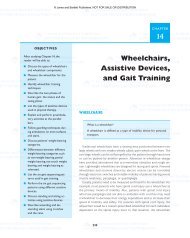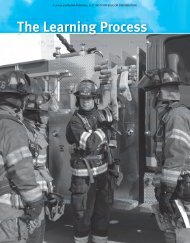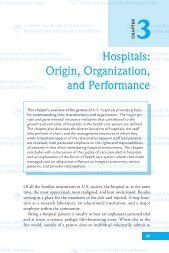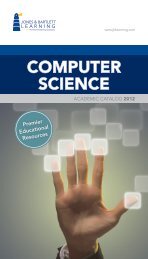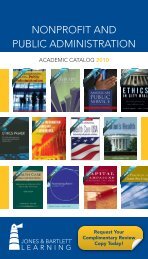CHAPTER - Jones & Bartlett Learning
CHAPTER - Jones & Bartlett Learning
CHAPTER - Jones & Bartlett Learning
Create successful ePaper yourself
Turn your PDF publications into a flip-book with our unique Google optimized e-Paper software.
30017_CH15_398_431_r7.qxp 4/7/06 3:13 PM Page 416<br />
© <strong>Jones</strong> and <strong>Bartlett</strong> Publishers. NOT FOR SALE OR DISTRIBUTION<br />
1<br />
2<br />
3<br />
4<br />
5<br />
6<br />
7<br />
8<br />
9<br />
10<br />
11<br />
12<br />
13<br />
14<br />
15<br />
16<br />
17<br />
18<br />
19<br />
20<br />
21<br />
22<br />
23<br />
24<br />
25<br />
26<br />
27<br />
28<br />
29<br />
30<br />
31<br />
32<br />
33<br />
34<br />
35<br />
36<br />
37<br />
38<br />
39<br />
40<br />
41<br />
42<br />
43<br />
44<br />
45<br />
46<br />
47<br />
48<br />
49<br />
50<br />
51<br />
52<br />
viduals, usually an elite group (e.g., physicians,<br />
attorneys, and psychologists). Several studies<br />
have detected high levels of fraud committed by<br />
physicians against the Medicare and Medicaid<br />
programs. For example, doctors have submitted<br />
bills for procedures (e.g., x-rays and blood and<br />
urine tests) that were either unnecessary or<br />
never performed. 81 Psychiatrists have been sanctioned<br />
for charging the cost of individual therapy<br />
for patients treated in a group, billing for “therapy”<br />
that involved sexual contact between patient<br />
and physician, and generally inflating the<br />
cost of treatment. 82 In these offenses, the victim<br />
was not only the individual but also the taxpayer.<br />
It is difficult to detect and effectively sanction<br />
crimes committed under the veil of professional<br />
confidentiality by autonomous practitioners. 83<br />
4. Occupational crimes committed by individuals for<br />
personal gain. Put simply, these individuals have<br />
the same motives as armed robbers or muggers.<br />
Another study of auto repair shops revealed that<br />
they may misrepresent the need for a new car<br />
battery. Honesty was related to the presence of<br />
the owner, the economic health of the shop, incentive<br />
or commission payment procedures,<br />
and the longevity of the current management. 84<br />
Interventions (e.g., public service announcements,<br />
filing of a suit against a major dealer, and<br />
a letter from the California Bureau of Automobile<br />
Repair) did not deter dishonest dealers. 85<br />
Clearly, the individual salesperson was attempting<br />
to gain through the sale of a new battery.<br />
Corporate Crime<br />
Kramer defines corporate crime as 86 :<br />
crimes committed by corporate organizations.<br />
They are the result of deliberate decision making<br />
by persons who occupy structural positions<br />
within the organization. The organization makes<br />
decisions intentionally to benefit itself.<br />
Two of the most infamous examples of corporate<br />
crime are the Ford Pinto case and the savings and<br />
loan scandal.<br />
Ford Pinto Scandal<br />
An article in Mother <strong>Jones</strong> magazine brought the Ford<br />
Pinto case to the attention of the public. Mark<br />
Dowie accused Ford Motor Company of ignoring a<br />
life-threatening defect in its profitable subcompact,<br />
the Pinto. Ford crash tested the Pinto and discovered<br />
that in every test performed at over 25 miles<br />
per hour, the fuel tank ruptured. Although inexpensive<br />
modifications ($11 per car) would have<br />
prevented any threat of fire, Ford decided not to<br />
issue a recall. An internal cost–benefit analysis estimated<br />
that the recall would cost Ford approximately<br />
$137 million, although 180 burn deaths<br />
would result in a company loss of only $49.5 million.<br />
87 In August of 1978, three Indiana teenagers<br />
died when a rear-end collision caused their Pinto to<br />
burst into flames. In 1980, Ford Motor Company<br />
was indicted and brought to trial in Indiana under<br />
the reckless homicide provision of a state law. It<br />
was charged with building a dangerous vehicle and<br />
ignoring the company’s duty to protect its customers<br />
from known dangers. 88 The trial resulted in<br />
a jury verdict of not guilty. Nevertheless, the case<br />
clearly established that a corporation could face<br />
criminal liability because of its actions. 89<br />
Savings and Loan Scandal<br />
The savings and loan (S&L) crisis introduced a new<br />
form of corporate criminality: collective embezzlement<br />
— the siphoning of company funds for personal<br />
use by top management at the expense of the<br />
institution itself and with the implicit or explicit<br />
sanction of its management. 90 In effect, the S&L<br />
executives robbed their own banks.<br />
During the 1970s, stagflation, high interest rates,<br />
and slow growth plagued the S&L industry. In addition,<br />
the development of money market mutual<br />
funds led to massive withdrawals from S&Ls. The<br />
Reagan administration pushed deregulation as the<br />
cure for the ills plaguing these institutions. The belief<br />
was that loosening restraints would make S&Ls<br />
more competitive under the “self-regulating mechanisms<br />
of the free market.” Thus, restrictions on interest<br />
rates paid by S&Ls were phased out.<br />
Simultaneously, the federal protection offered by<br />
the Federal Savings and Loan Insurance Corporation<br />
was raised from a maximum of $40,000 to<br />
$100,000 per deposit.<br />
The loosening of federal restrictions permitted<br />
such practices as linked financing (“daisy chains”)<br />
to occur. Here, deposits were made and loans were<br />
made to the depositors. The brokers defaulted on<br />
the loans, essentially obtaining free cash (“drag<br />
loans”). Middlemen received a generous “finder’s<br />
fee,” and S&L operators recorded hefty deposits<br />
and inflated assets, which spelled extra bonuses<br />
and dividends for S&L executives.<br />
These practices developed under the S&Lsponsored<br />
“casino economy.” Speculative ventures<br />
416 <strong>CHAPTER</strong> 15 Crimes of the Powerful<br />
1st pass Pages



